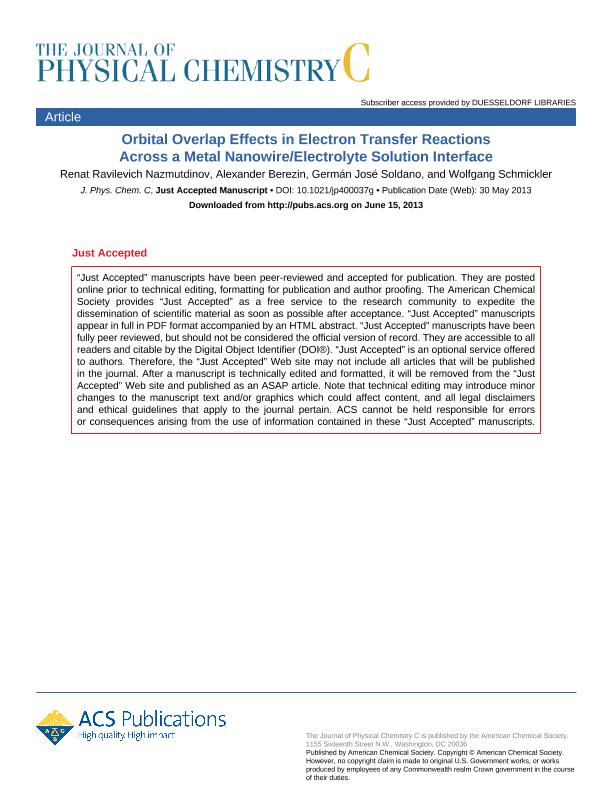Mostrar el registro sencillo del ítem
dc.contributor.author
Nazmutdinov, Renat R.
dc.contributor.author
Berezin, Alexander S.
dc.contributor.author
Soldano, Germán

dc.contributor.author
Schmickler, Wolfgang

dc.date.available
2017-09-01T18:01:18Z
dc.date.issued
2013-05
dc.identifier.citation
Nazmutdinov, Renat R.; Berezin, Alexander S.; Soldano, Germán; Schmickler, Wolfgang; Orbital overlap effects in electron transfer reactions across a metal nanowire/electrolyte solution interface; American Chemical Society; Journal of Physical Chemistry C; 117; 25; 5-2013; 13021-13027
dc.identifier.issn
1932-7447
dc.identifier.uri
http://hdl.handle.net/11336/23447
dc.description.abstract
In this paper, we report on calculations of the orbital overlap between Fe(III) and Cr(III) aquacomplexes and different electrode surfaces: Cu(111), Ag (111), Au(111), Pt(111), and corresponding monatomic wires. The electronic structure of the monocrystalline surfaces and nanowires are described in terms of the electronic spillover and density of electronic states at the Fermi level obtained from periodic density functional theory (DFT) calculations. The transmission coefficients (κ) characterizing the first stage of outer-sphere electron transfer for the reduction of aquacomplexes are calculated on the basis of Landau–Zener theory as a function of electrode–reactant separation; the electronic transmission coefficients for the [Cr(H2O)6]3+/2+ redox couple were found to be smaller than those for [Fe(H2O)6]3+/2+. Two different intervals can be clearly distinguished for Cu, Au and Pt: “a catalytic region”, where κ(wire) > κ(Me slab) and “an inhibition region”, where κ(wire) < κ(Me slab). A similar behavior exhibits the coupling constant estimated for a hydrogen atom adsorbed at the Au(111) surface and the Au monatomic wire. These effects originate from some specific features of electronic density profile for metal nanowires: at short distances the electronic density of nanowires is higher compared with the (111) metal surfaces, while at larger separations it decreases more sharply.
dc.format
application/pdf
dc.language.iso
eng
dc.publisher
American Chemical Society

dc.rights
info:eu-repo/semantics/openAccess
dc.rights.uri
https://creativecommons.org/licenses/by-nc-sa/2.5/ar/
dc.subject
Electron Transfer
dc.subject
Metallic Nanowires
dc.subject
Density Functional Theory
dc.subject
Transmission Coefficient
dc.subject.classification
Otras Ciencias Químicas

dc.subject.classification
Ciencias Químicas

dc.subject.classification
CIENCIAS NATURALES Y EXACTAS

dc.title
Orbital overlap effects in electron transfer reactions across a metal nanowire/electrolyte solution interface
dc.type
info:eu-repo/semantics/article
dc.type
info:ar-repo/semantics/artículo
dc.type
info:eu-repo/semantics/publishedVersion
dc.date.updated
2017-08-30T13:54:04Z
dc.journal.volume
117
dc.journal.number
25
dc.journal.pagination
13021-13027
dc.journal.pais
Estados Unidos

dc.journal.ciudad
Washington DC
dc.conicet.avisoEditorial
This document is the Accepted Manuscript version of a Published Work that appeared in final form in J. Phys. Chem. C,, copyright © 2013 American Chemical Society after peer review and technical editing by the publisher. To access the final edited and published work see http://dx.doi.org/10.1021/jp400037g
dc.description.fil
Fil: Nazmutdinov, Renat R.. Kazan National Research Technological University; Rusia
dc.description.fil
Fil: Berezin, Alexander S.. Kazan National Research Technological University; Rusia
dc.description.fil
Fil: Soldano, Germán. Universitat Ulm; Alemania. Consejo Nacional de Investigaciones Científicas y Técnicas; Argentina
dc.description.fil
Fil: Schmickler, Wolfgang. Universitat Ulm; Alemania
dc.journal.title
Journal of Physical Chemistry C

dc.relation.alternativeid
info:eu-repo/semantics/altIdentifier/doi/http://dx.doi.org/10.1021/jp400037g
dc.relation.alternativeid
info:eu-repo/semantics/altIdentifier/url/http://pubs.acs.org/doi/abs/10.1021/jp400037g
Archivos asociados
